Global Business Environment– Assignment
VerifiedAdded on 2021/02/20
|12
|3691
|43
AI Summary
Contribute Materials
Your contribution can guide someone’s learning journey. Share your
documents today.
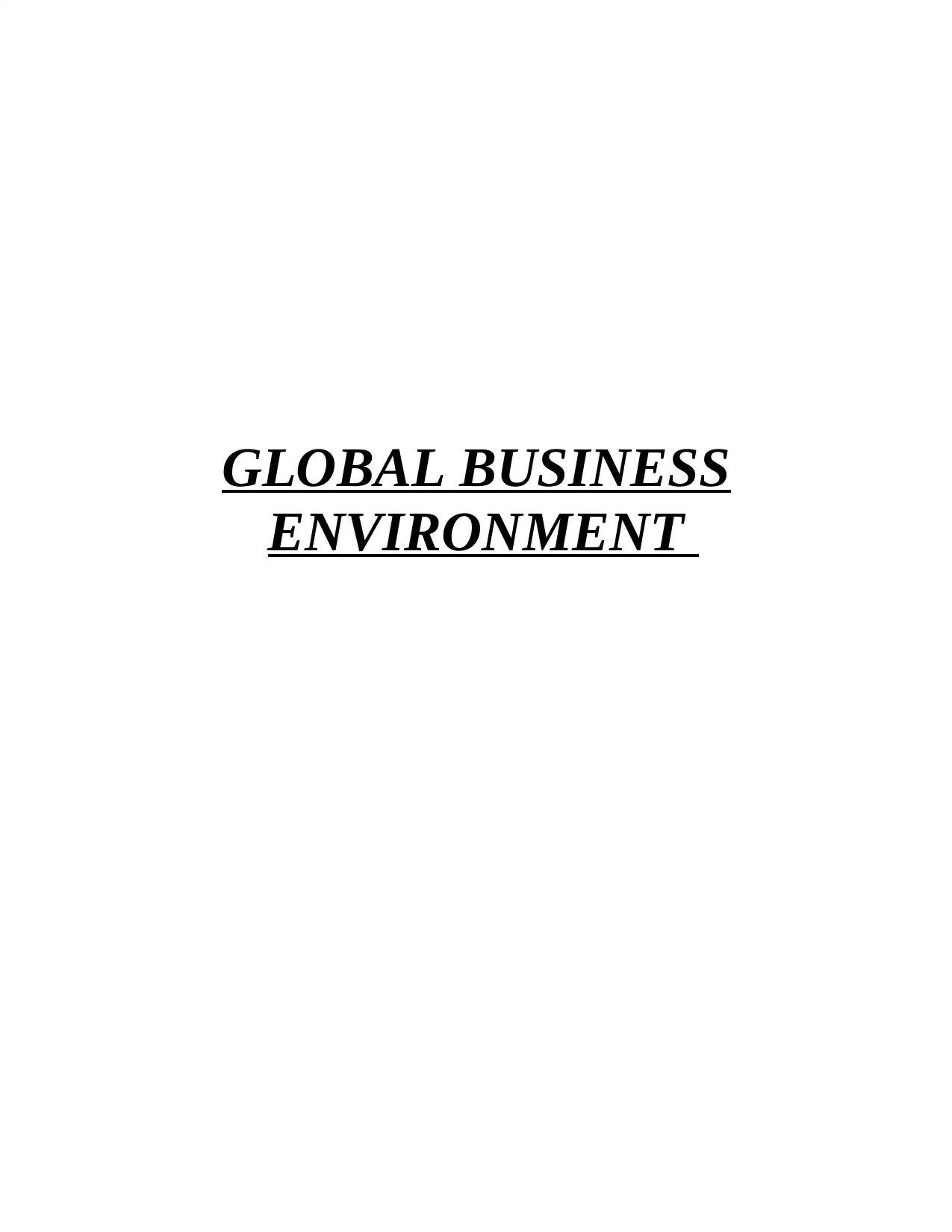
GLOBAL BUSINESS
ENVIRONMENT
ENVIRONMENT
Secure Best Marks with AI Grader
Need help grading? Try our AI Grader for instant feedback on your assignments.
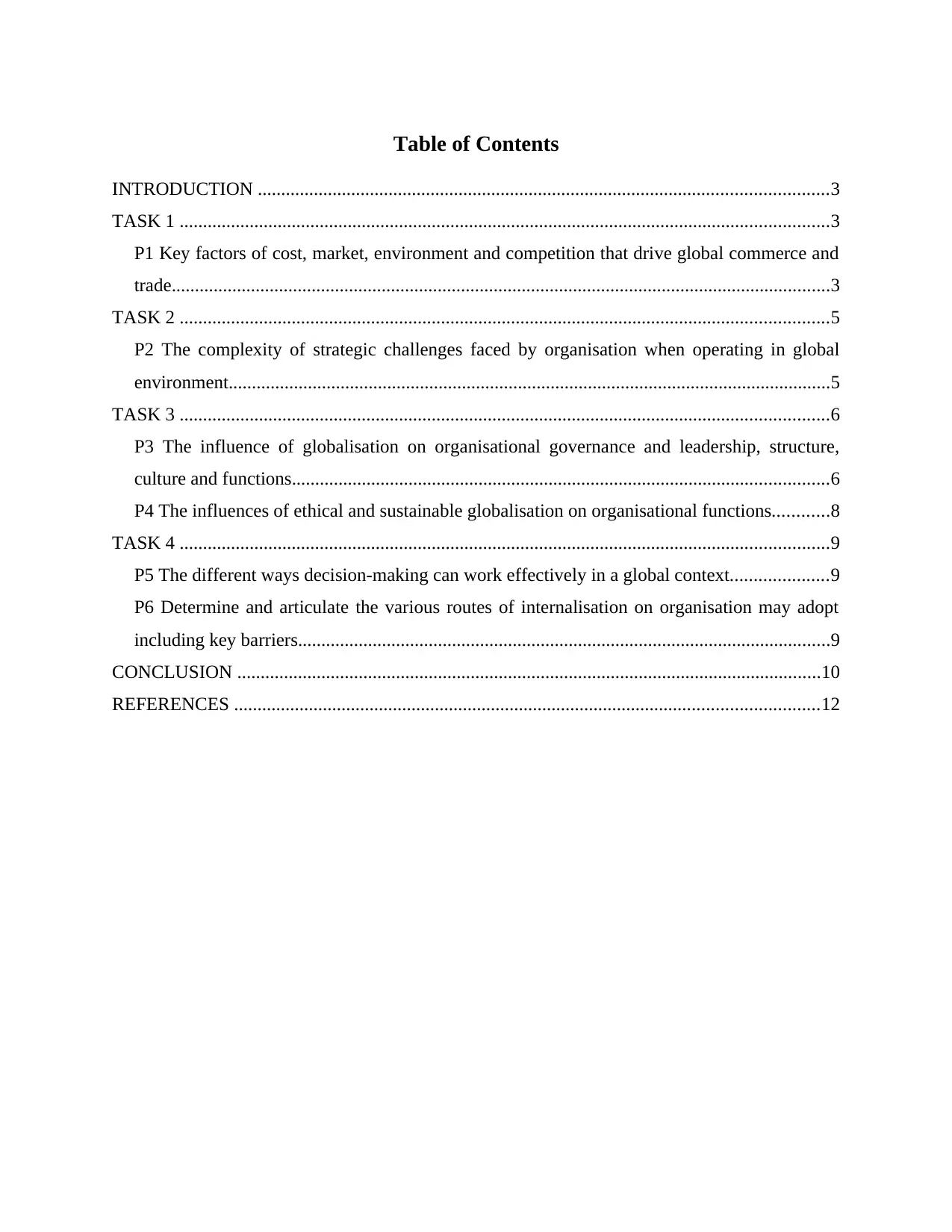
Table of Contents
INTRODUCTION ..........................................................................................................................3
TASK 1 ...........................................................................................................................................3
P1 Key factors of cost, market, environment and competition that drive global commerce and
trade.............................................................................................................................................3
TASK 2 ...........................................................................................................................................5
P2 The complexity of strategic challenges faced by organisation when operating in global
environment.................................................................................................................................5
TASK 3 ...........................................................................................................................................6
P3 The influence of globalisation on organisational governance and leadership, structure,
culture and functions...................................................................................................................6
P4 The influences of ethical and sustainable globalisation on organisational functions............8
TASK 4 ...........................................................................................................................................9
P5 The different ways decision-making can work effectively in a global context.....................9
P6 Determine and articulate the various routes of internalisation on organisation may adopt
including key barriers..................................................................................................................9
CONCLUSION .............................................................................................................................10
REFERENCES .............................................................................................................................12
INTRODUCTION ..........................................................................................................................3
TASK 1 ...........................................................................................................................................3
P1 Key factors of cost, market, environment and competition that drive global commerce and
trade.............................................................................................................................................3
TASK 2 ...........................................................................................................................................5
P2 The complexity of strategic challenges faced by organisation when operating in global
environment.................................................................................................................................5
TASK 3 ...........................................................................................................................................6
P3 The influence of globalisation on organisational governance and leadership, structure,
culture and functions...................................................................................................................6
P4 The influences of ethical and sustainable globalisation on organisational functions............8
TASK 4 ...........................................................................................................................................9
P5 The different ways decision-making can work effectively in a global context.....................9
P6 Determine and articulate the various routes of internalisation on organisation may adopt
including key barriers..................................................................................................................9
CONCLUSION .............................................................................................................................10
REFERENCES .............................................................................................................................12
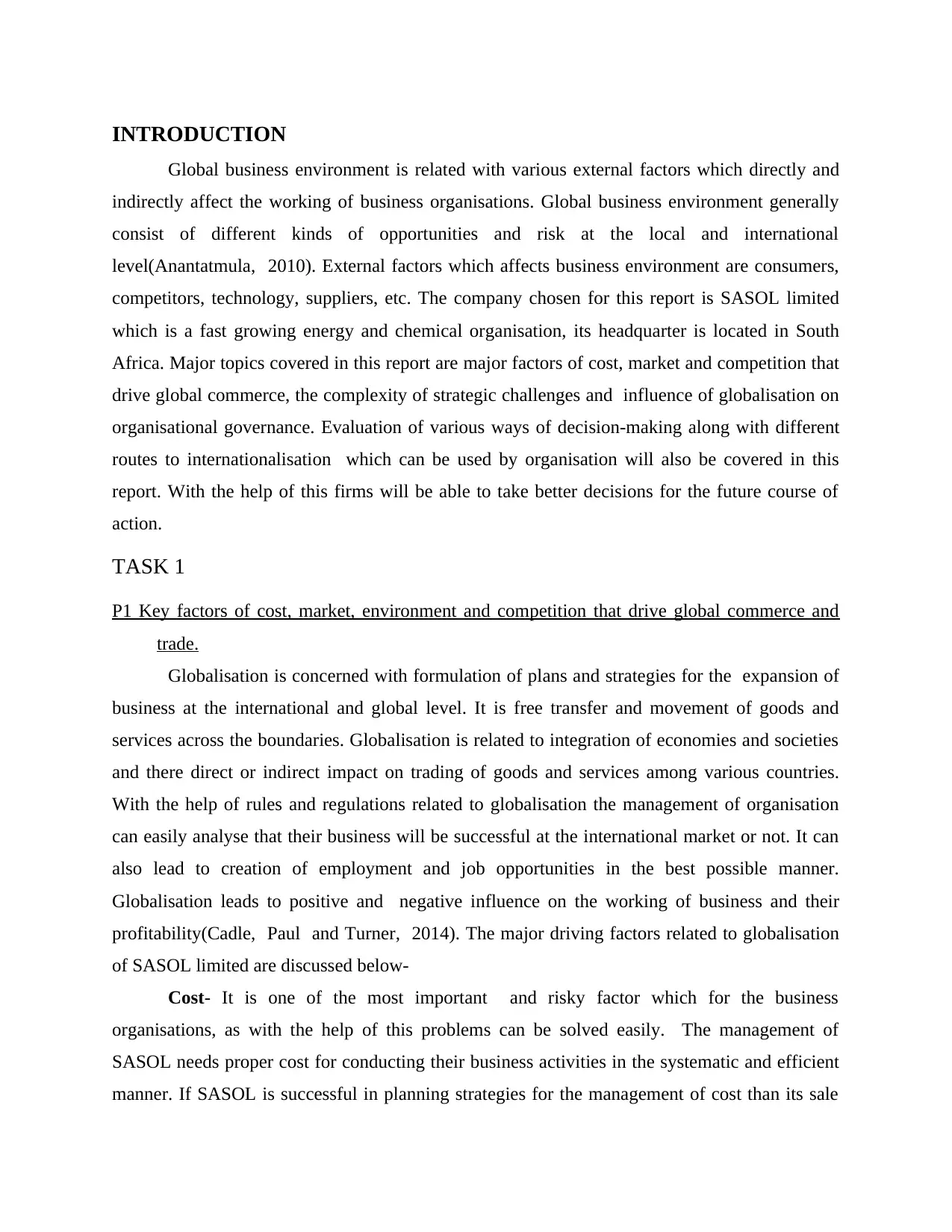
INTRODUCTION
Global business environment is related with various external factors which directly and
indirectly affect the working of business organisations. Global business environment generally
consist of different kinds of opportunities and risk at the local and international
level(Anantatmula, 2010). External factors which affects business environment are consumers,
competitors, technology, suppliers, etc. The company chosen for this report is SASOL limited
which is a fast growing energy and chemical organisation, its headquarter is located in South
Africa. Major topics covered in this report are major factors of cost, market and competition that
drive global commerce, the complexity of strategic challenges and influence of globalisation on
organisational governance. Evaluation of various ways of decision-making along with different
routes to internationalisation which can be used by organisation will also be covered in this
report. With the help of this firms will be able to take better decisions for the future course of
action.
TASK 1
P1 Key factors of cost, market, environment and competition that drive global commerce and
trade.
Globalisation is concerned with formulation of plans and strategies for the expansion of
business at the international and global level. It is free transfer and movement of goods and
services across the boundaries. Globalisation is related to integration of economies and societies
and there direct or indirect impact on trading of goods and services among various countries.
With the help of rules and regulations related to globalisation the management of organisation
can easily analyse that their business will be successful at the international market or not. It can
also lead to creation of employment and job opportunities in the best possible manner.
Globalisation leads to positive and negative influence on the working of business and their
profitability(Cadle, Paul and Turner, 2014). The major driving factors related to globalisation
of SASOL limited are discussed below-
Cost- It is one of the most important and risky factor which for the business
organisations, as with the help of this problems can be solved easily. The management of
SASOL needs proper cost for conducting their business activities in the systematic and efficient
manner. If SASOL is successful in planning strategies for the management of cost than its sale
Global business environment is related with various external factors which directly and
indirectly affect the working of business organisations. Global business environment generally
consist of different kinds of opportunities and risk at the local and international
level(Anantatmula, 2010). External factors which affects business environment are consumers,
competitors, technology, suppliers, etc. The company chosen for this report is SASOL limited
which is a fast growing energy and chemical organisation, its headquarter is located in South
Africa. Major topics covered in this report are major factors of cost, market and competition that
drive global commerce, the complexity of strategic challenges and influence of globalisation on
organisational governance. Evaluation of various ways of decision-making along with different
routes to internationalisation which can be used by organisation will also be covered in this
report. With the help of this firms will be able to take better decisions for the future course of
action.
TASK 1
P1 Key factors of cost, market, environment and competition that drive global commerce and
trade.
Globalisation is concerned with formulation of plans and strategies for the expansion of
business at the international and global level. It is free transfer and movement of goods and
services across the boundaries. Globalisation is related to integration of economies and societies
and there direct or indirect impact on trading of goods and services among various countries.
With the help of rules and regulations related to globalisation the management of organisation
can easily analyse that their business will be successful at the international market or not. It can
also lead to creation of employment and job opportunities in the best possible manner.
Globalisation leads to positive and negative influence on the working of business and their
profitability(Cadle, Paul and Turner, 2014). The major driving factors related to globalisation
of SASOL limited are discussed below-
Cost- It is one of the most important and risky factor which for the business
organisations, as with the help of this problems can be solved easily. The management of
SASOL needs proper cost for conducting their business activities in the systematic and efficient
manner. If SASOL is successful in planning strategies for the management of cost than its sale
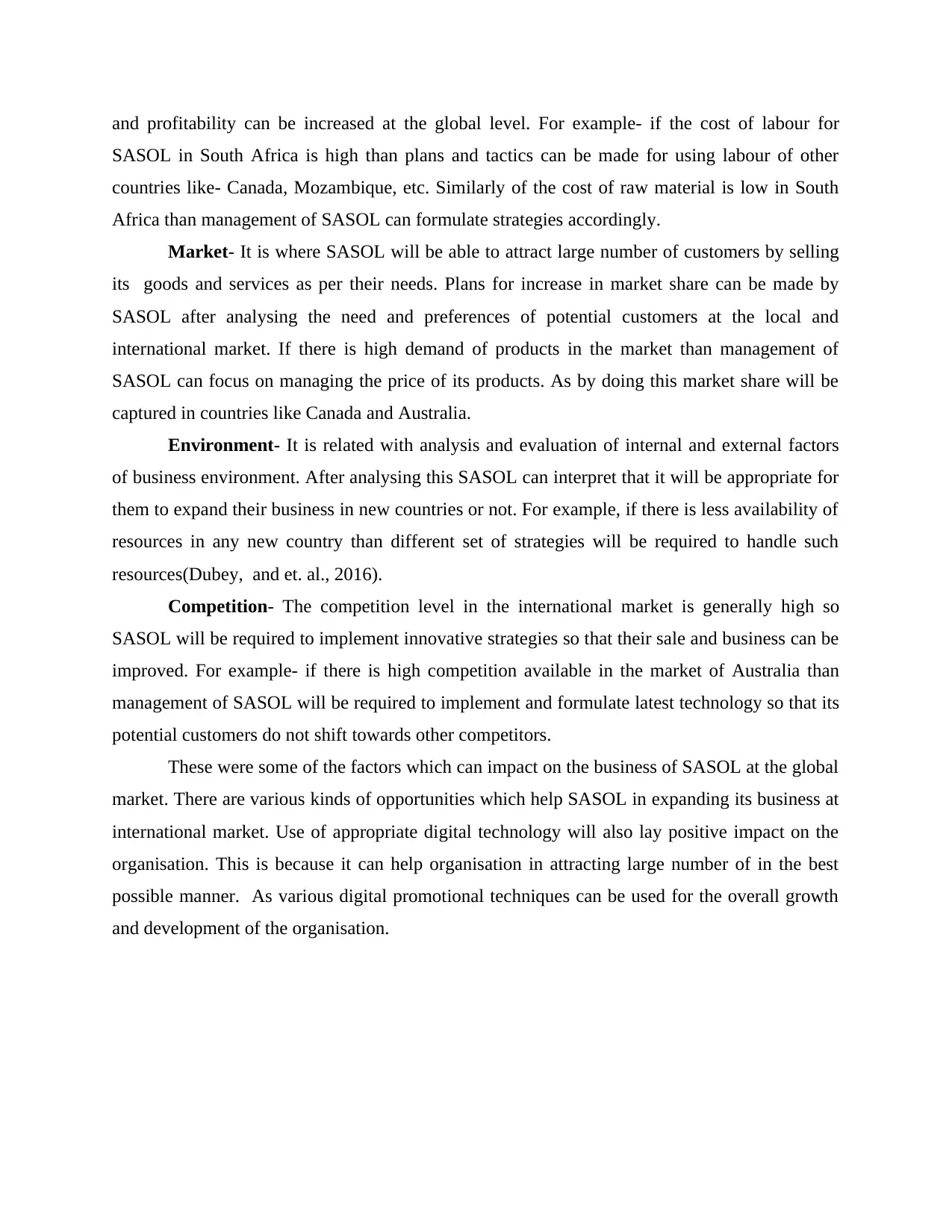
and profitability can be increased at the global level. For example- if the cost of labour for
SASOL in South Africa is high than plans and tactics can be made for using labour of other
countries like- Canada, Mozambique, etc. Similarly of the cost of raw material is low in South
Africa than management of SASOL can formulate strategies accordingly.
Market- It is where SASOL will be able to attract large number of customers by selling
its goods and services as per their needs. Plans for increase in market share can be made by
SASOL after analysing the need and preferences of potential customers at the local and
international market. If there is high demand of products in the market than management of
SASOL can focus on managing the price of its products. As by doing this market share will be
captured in countries like Canada and Australia.
Environment- It is related with analysis and evaluation of internal and external factors
of business environment. After analysing this SASOL can interpret that it will be appropriate for
them to expand their business in new countries or not. For example, if there is less availability of
resources in any new country than different set of strategies will be required to handle such
resources(Dubey, and et. al., 2016).
Competition- The competition level in the international market is generally high so
SASOL will be required to implement innovative strategies so that their sale and business can be
improved. For example- if there is high competition available in the market of Australia than
management of SASOL will be required to implement and formulate latest technology so that its
potential customers do not shift towards other competitors.
These were some of the factors which can impact on the business of SASOL at the global
market. There are various kinds of opportunities which help SASOL in expanding its business at
international market. Use of appropriate digital technology will also lay positive impact on the
organisation. This is because it can help organisation in attracting large number of in the best
possible manner. As various digital promotional techniques can be used for the overall growth
and development of the organisation.
SASOL in South Africa is high than plans and tactics can be made for using labour of other
countries like- Canada, Mozambique, etc. Similarly of the cost of raw material is low in South
Africa than management of SASOL can formulate strategies accordingly.
Market- It is where SASOL will be able to attract large number of customers by selling
its goods and services as per their needs. Plans for increase in market share can be made by
SASOL after analysing the need and preferences of potential customers at the local and
international market. If there is high demand of products in the market than management of
SASOL can focus on managing the price of its products. As by doing this market share will be
captured in countries like Canada and Australia.
Environment- It is related with analysis and evaluation of internal and external factors
of business environment. After analysing this SASOL can interpret that it will be appropriate for
them to expand their business in new countries or not. For example, if there is less availability of
resources in any new country than different set of strategies will be required to handle such
resources(Dubey, and et. al., 2016).
Competition- The competition level in the international market is generally high so
SASOL will be required to implement innovative strategies so that their sale and business can be
improved. For example- if there is high competition available in the market of Australia than
management of SASOL will be required to implement and formulate latest technology so that its
potential customers do not shift towards other competitors.
These were some of the factors which can impact on the business of SASOL at the global
market. There are various kinds of opportunities which help SASOL in expanding its business at
international market. Use of appropriate digital technology will also lay positive impact on the
organisation. This is because it can help organisation in attracting large number of in the best
possible manner. As various digital promotional techniques can be used for the overall growth
and development of the organisation.
Secure Best Marks with AI Grader
Need help grading? Try our AI Grader for instant feedback on your assignments.
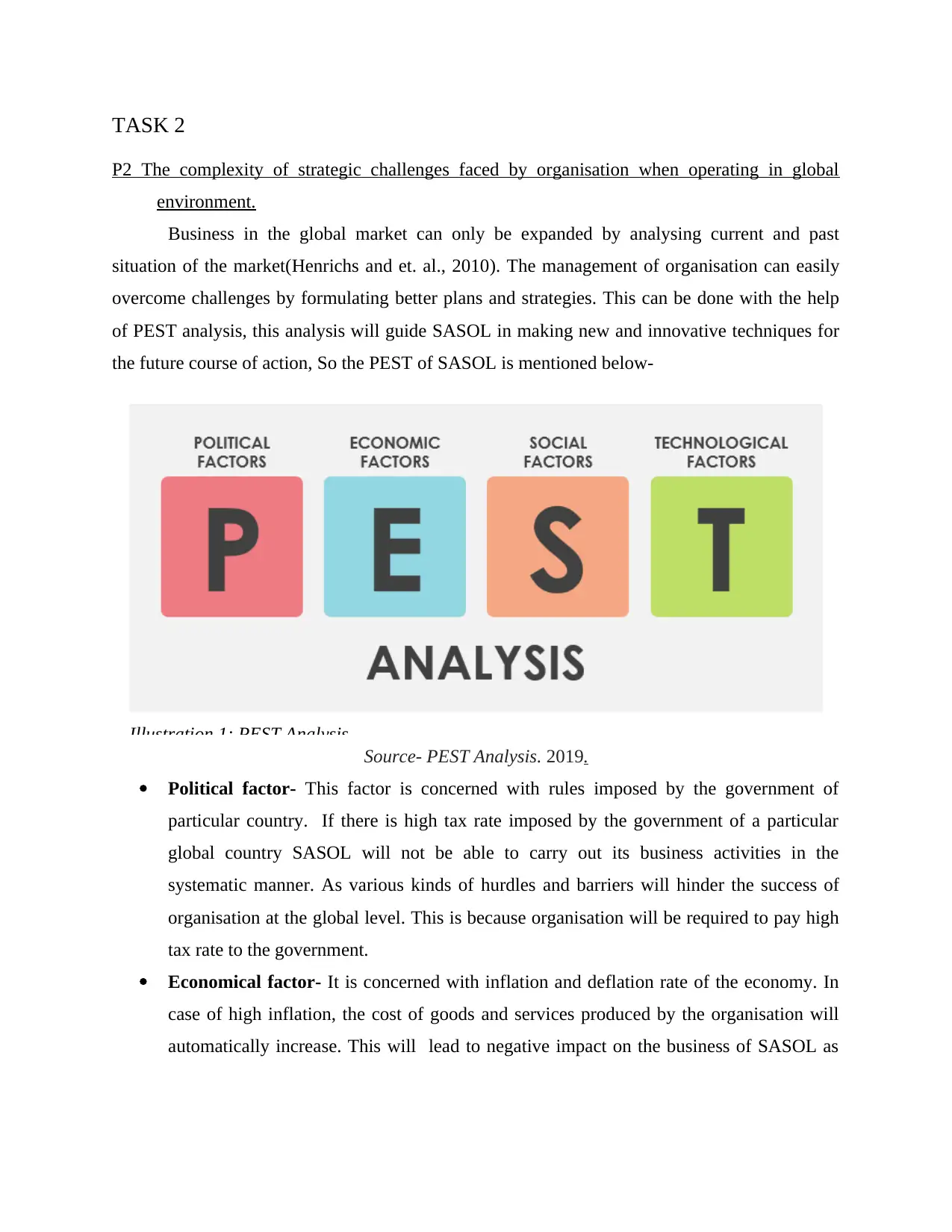
TASK 2
P2 The complexity of strategic challenges faced by organisation when operating in global
environment.
Business in the global market can only be expanded by analysing current and past
situation of the market(Henrichs and et. al., 2010). The management of organisation can easily
overcome challenges by formulating better plans and strategies. This can be done with the help
of PEST analysis, this analysis will guide SASOL in making new and innovative techniques for
the future course of action, So the PEST of SASOL is mentioned below-
Source- PEST Analysis. 2019.
Political factor- This factor is concerned with rules imposed by the government of
particular country. If there is high tax rate imposed by the government of a particular
global country SASOL will not be able to carry out its business activities in the
systematic manner. As various kinds of hurdles and barriers will hinder the success of
organisation at the global level. This is because organisation will be required to pay high
tax rate to the government.
Economical factor- It is concerned with inflation and deflation rate of the economy. In
case of high inflation, the cost of goods and services produced by the organisation will
automatically increase. This will lead to negative impact on the business of SASOL as
Illustration 1: PEST Analysis
P2 The complexity of strategic challenges faced by organisation when operating in global
environment.
Business in the global market can only be expanded by analysing current and past
situation of the market(Henrichs and et. al., 2010). The management of organisation can easily
overcome challenges by formulating better plans and strategies. This can be done with the help
of PEST analysis, this analysis will guide SASOL in making new and innovative techniques for
the future course of action, So the PEST of SASOL is mentioned below-
Source- PEST Analysis. 2019.
Political factor- This factor is concerned with rules imposed by the government of
particular country. If there is high tax rate imposed by the government of a particular
global country SASOL will not be able to carry out its business activities in the
systematic manner. As various kinds of hurdles and barriers will hinder the success of
organisation at the global level. This is because organisation will be required to pay high
tax rate to the government.
Economical factor- It is concerned with inflation and deflation rate of the economy. In
case of high inflation, the cost of goods and services produced by the organisation will
automatically increase. This will lead to negative impact on the business of SASOL as
Illustration 1: PEST Analysis
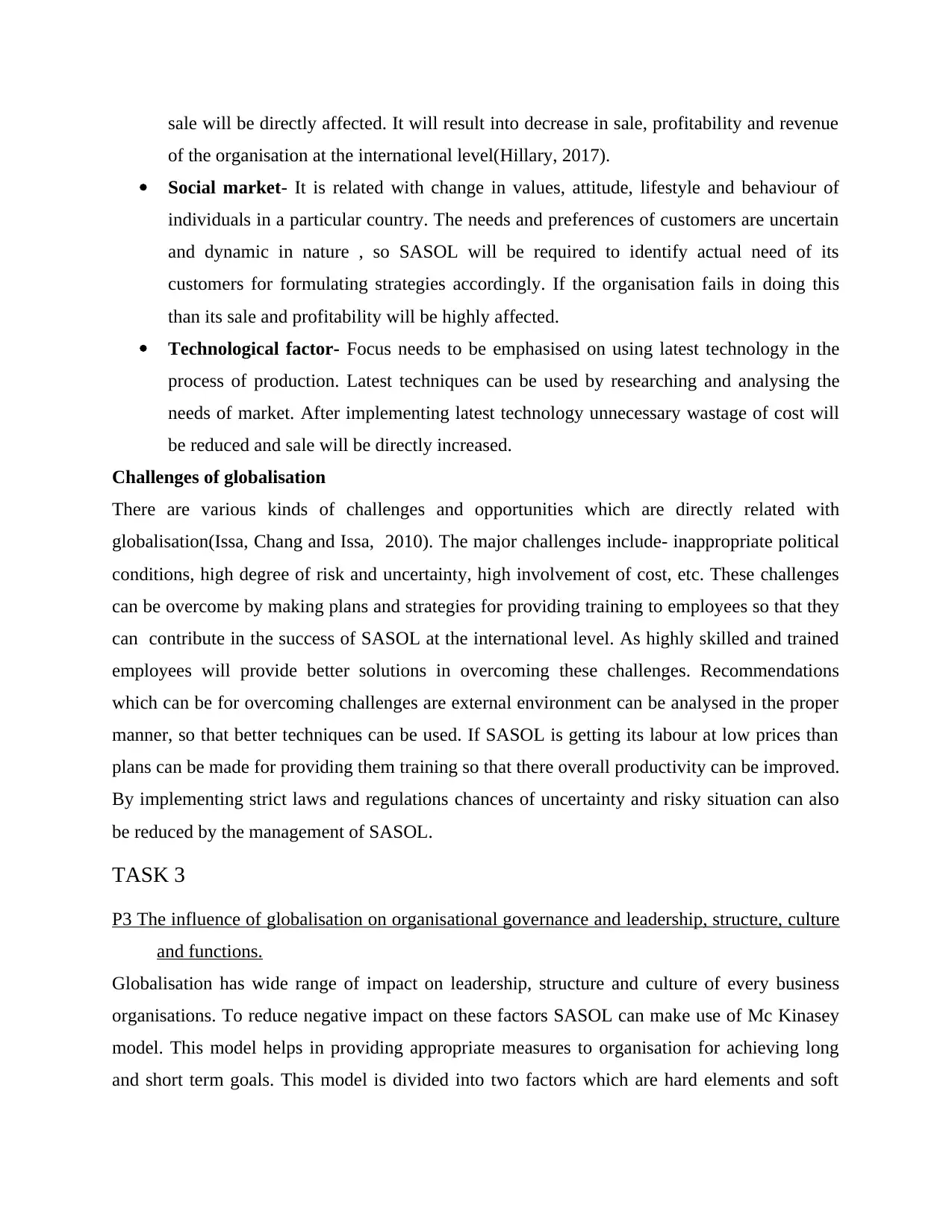
sale will be directly affected. It will result into decrease in sale, profitability and revenue
of the organisation at the international level(Hillary, 2017).
Social market- It is related with change in values, attitude, lifestyle and behaviour of
individuals in a particular country. The needs and preferences of customers are uncertain
and dynamic in nature , so SASOL will be required to identify actual need of its
customers for formulating strategies accordingly. If the organisation fails in doing this
than its sale and profitability will be highly affected.
Technological factor- Focus needs to be emphasised on using latest technology in the
process of production. Latest techniques can be used by researching and analysing the
needs of market. After implementing latest technology unnecessary wastage of cost will
be reduced and sale will be directly increased.
Challenges of globalisation
There are various kinds of challenges and opportunities which are directly related with
globalisation(Issa, Chang and Issa, 2010). The major challenges include- inappropriate political
conditions, high degree of risk and uncertainty, high involvement of cost, etc. These challenges
can be overcome by making plans and strategies for providing training to employees so that they
can contribute in the success of SASOL at the international level. As highly skilled and trained
employees will provide better solutions in overcoming these challenges. Recommendations
which can be for overcoming challenges are external environment can be analysed in the proper
manner, so that better techniques can be used. If SASOL is getting its labour at low prices than
plans can be made for providing them training so that there overall productivity can be improved.
By implementing strict laws and regulations chances of uncertainty and risky situation can also
be reduced by the management of SASOL.
TASK 3
P3 The influence of globalisation on organisational governance and leadership, structure, culture
and functions.
Globalisation has wide range of impact on leadership, structure and culture of every business
organisations. To reduce negative impact on these factors SASOL can make use of Mc Kinasey
model. This model helps in providing appropriate measures to organisation for achieving long
and short term goals. This model is divided into two factors which are hard elements and soft
of the organisation at the international level(Hillary, 2017).
Social market- It is related with change in values, attitude, lifestyle and behaviour of
individuals in a particular country. The needs and preferences of customers are uncertain
and dynamic in nature , so SASOL will be required to identify actual need of its
customers for formulating strategies accordingly. If the organisation fails in doing this
than its sale and profitability will be highly affected.
Technological factor- Focus needs to be emphasised on using latest technology in the
process of production. Latest techniques can be used by researching and analysing the
needs of market. After implementing latest technology unnecessary wastage of cost will
be reduced and sale will be directly increased.
Challenges of globalisation
There are various kinds of challenges and opportunities which are directly related with
globalisation(Issa, Chang and Issa, 2010). The major challenges include- inappropriate political
conditions, high degree of risk and uncertainty, high involvement of cost, etc. These challenges
can be overcome by making plans and strategies for providing training to employees so that they
can contribute in the success of SASOL at the international level. As highly skilled and trained
employees will provide better solutions in overcoming these challenges. Recommendations
which can be for overcoming challenges are external environment can be analysed in the proper
manner, so that better techniques can be used. If SASOL is getting its labour at low prices than
plans can be made for providing them training so that there overall productivity can be improved.
By implementing strict laws and regulations chances of uncertainty and risky situation can also
be reduced by the management of SASOL.
TASK 3
P3 The influence of globalisation on organisational governance and leadership, structure, culture
and functions.
Globalisation has wide range of impact on leadership, structure and culture of every business
organisations. To reduce negative impact on these factors SASOL can make use of Mc Kinasey
model. This model helps in providing appropriate measures to organisation for achieving long
and short term goals. This model is divided into two factors which are hard elements and soft

elements(Knetsch and et. al., 2012). With the help of this model SASOL will be able to make
major changes in its working structure for international market. Mc Kinsey 7 S model for
SASOL is discussed below-
Strategy- It is related with combination of different plans which are made for achieving
goals in the best possible manner. By formulating appropriate strategy SASOL can easily
achieve competitive advantage at the local and international market. Chances of negative impact
of globalisation can be reduced by setting best strategies and polices.
Structure- Organisations generally requires appropriate structure for completing the task
in the best possible manner. This factor will guide SASOL in assigning roles and responsibilities
to every employees as per there skills and capabilities. By doing this work for global market will
be planned in the systematic and desirable manner.
System- It is related with management of day to day activities in the proper and
coordinated manner(Perera, 2017). The major focus of this factor is to take better decisions for
the achievement of goals within limited period of time. It will also guide SASOL in making
major changes in the working structure for reducing negative impact of global business
environment.
Skills- It is related with skills, knowledge and capabilities of the individuals for
performing certain activities in a appropriate manner. With the help of this assigned work can be
completed before its deadline because each and every activity will be accordingly planned at the
global level. The employees of SASOL will be able to work in the effective and efficient
manner.
Staff- It is related with individuals who are working with SASOL for the achievement og
common goal and objective. Plans and strategies can be made for improving and enhancing skills
of those individuals so that goals of global market can be achieved.
Style- This factor is concerned with technique or method of competing a particular task.
The management of SASOL can tries to improve the communication with its employees so that
their needs and preferences are fulfilled. In this work will be properly delegated so that chances
of mismanagement can be reduced.
Shared value- It is concerned with rules and regulations used by SASOL for guiding
workforce in the appropriate manner(Shenkar, Luo and Chi, 2014).
Hofstede's Cultural dimension model
major changes in its working structure for international market. Mc Kinsey 7 S model for
SASOL is discussed below-
Strategy- It is related with combination of different plans which are made for achieving
goals in the best possible manner. By formulating appropriate strategy SASOL can easily
achieve competitive advantage at the local and international market. Chances of negative impact
of globalisation can be reduced by setting best strategies and polices.
Structure- Organisations generally requires appropriate structure for completing the task
in the best possible manner. This factor will guide SASOL in assigning roles and responsibilities
to every employees as per there skills and capabilities. By doing this work for global market will
be planned in the systematic and desirable manner.
System- It is related with management of day to day activities in the proper and
coordinated manner(Perera, 2017). The major focus of this factor is to take better decisions for
the achievement of goals within limited period of time. It will also guide SASOL in making
major changes in the working structure for reducing negative impact of global business
environment.
Skills- It is related with skills, knowledge and capabilities of the individuals for
performing certain activities in a appropriate manner. With the help of this assigned work can be
completed before its deadline because each and every activity will be accordingly planned at the
global level. The employees of SASOL will be able to work in the effective and efficient
manner.
Staff- It is related with individuals who are working with SASOL for the achievement og
common goal and objective. Plans and strategies can be made for improving and enhancing skills
of those individuals so that goals of global market can be achieved.
Style- This factor is concerned with technique or method of competing a particular task.
The management of SASOL can tries to improve the communication with its employees so that
their needs and preferences are fulfilled. In this work will be properly delegated so that chances
of mismanagement can be reduced.
Shared value- It is concerned with rules and regulations used by SASOL for guiding
workforce in the appropriate manner(Shenkar, Luo and Chi, 2014).
Hofstede's Cultural dimension model
Paraphrase This Document
Need a fresh take? Get an instant paraphrase of this document with our AI Paraphraser
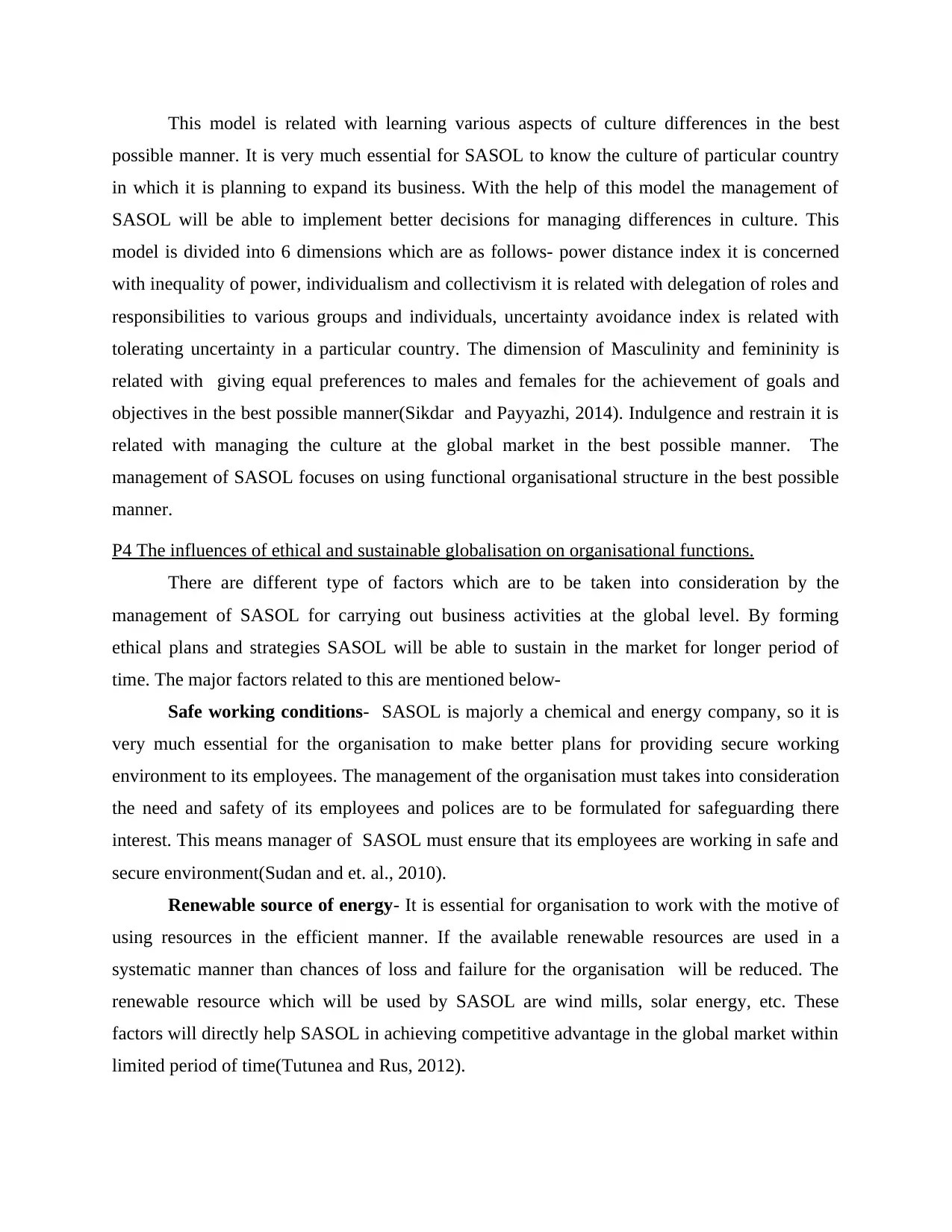
This model is related with learning various aspects of culture differences in the best
possible manner. It is very much essential for SASOL to know the culture of particular country
in which it is planning to expand its business. With the help of this model the management of
SASOL will be able to implement better decisions for managing differences in culture. This
model is divided into 6 dimensions which are as follows- power distance index it is concerned
with inequality of power, individualism and collectivism it is related with delegation of roles and
responsibilities to various groups and individuals, uncertainty avoidance index is related with
tolerating uncertainty in a particular country. The dimension of Masculinity and femininity is
related with giving equal preferences to males and females for the achievement of goals and
objectives in the best possible manner(Sikdar and Payyazhi, 2014). Indulgence and restrain it is
related with managing the culture at the global market in the best possible manner. The
management of SASOL focuses on using functional organisational structure in the best possible
manner.
P4 The influences of ethical and sustainable globalisation on organisational functions.
There are different type of factors which are to be taken into consideration by the
management of SASOL for carrying out business activities at the global level. By forming
ethical plans and strategies SASOL will be able to sustain in the market for longer period of
time. The major factors related to this are mentioned below-
Safe working conditions- SASOL is majorly a chemical and energy company, so it is
very much essential for the organisation to make better plans for providing secure working
environment to its employees. The management of the organisation must takes into consideration
the need and safety of its employees and polices are to be formulated for safeguarding there
interest. This means manager of SASOL must ensure that its employees are working in safe and
secure environment(Sudan and et. al., 2010).
Renewable source of energy- It is essential for organisation to work with the motive of
using resources in the efficient manner. If the available renewable resources are used in a
systematic manner than chances of loss and failure for the organisation will be reduced. The
renewable resource which will be used by SASOL are wind mills, solar energy, etc. These
factors will directly help SASOL in achieving competitive advantage in the global market within
limited period of time(Tutunea and Rus, 2012).
possible manner. It is very much essential for SASOL to know the culture of particular country
in which it is planning to expand its business. With the help of this model the management of
SASOL will be able to implement better decisions for managing differences in culture. This
model is divided into 6 dimensions which are as follows- power distance index it is concerned
with inequality of power, individualism and collectivism it is related with delegation of roles and
responsibilities to various groups and individuals, uncertainty avoidance index is related with
tolerating uncertainty in a particular country. The dimension of Masculinity and femininity is
related with giving equal preferences to males and females for the achievement of goals and
objectives in the best possible manner(Sikdar and Payyazhi, 2014). Indulgence and restrain it is
related with managing the culture at the global market in the best possible manner. The
management of SASOL focuses on using functional organisational structure in the best possible
manner.
P4 The influences of ethical and sustainable globalisation on organisational functions.
There are different type of factors which are to be taken into consideration by the
management of SASOL for carrying out business activities at the global level. By forming
ethical plans and strategies SASOL will be able to sustain in the market for longer period of
time. The major factors related to this are mentioned below-
Safe working conditions- SASOL is majorly a chemical and energy company, so it is
very much essential for the organisation to make better plans for providing secure working
environment to its employees. The management of the organisation must takes into consideration
the need and safety of its employees and polices are to be formulated for safeguarding there
interest. This means manager of SASOL must ensure that its employees are working in safe and
secure environment(Sudan and et. al., 2010).
Renewable source of energy- It is essential for organisation to work with the motive of
using resources in the efficient manner. If the available renewable resources are used in a
systematic manner than chances of loss and failure for the organisation will be reduced. The
renewable resource which will be used by SASOL are wind mills, solar energy, etc. These
factors will directly help SASOL in achieving competitive advantage in the global market within
limited period of time(Tutunea and Rus, 2012).
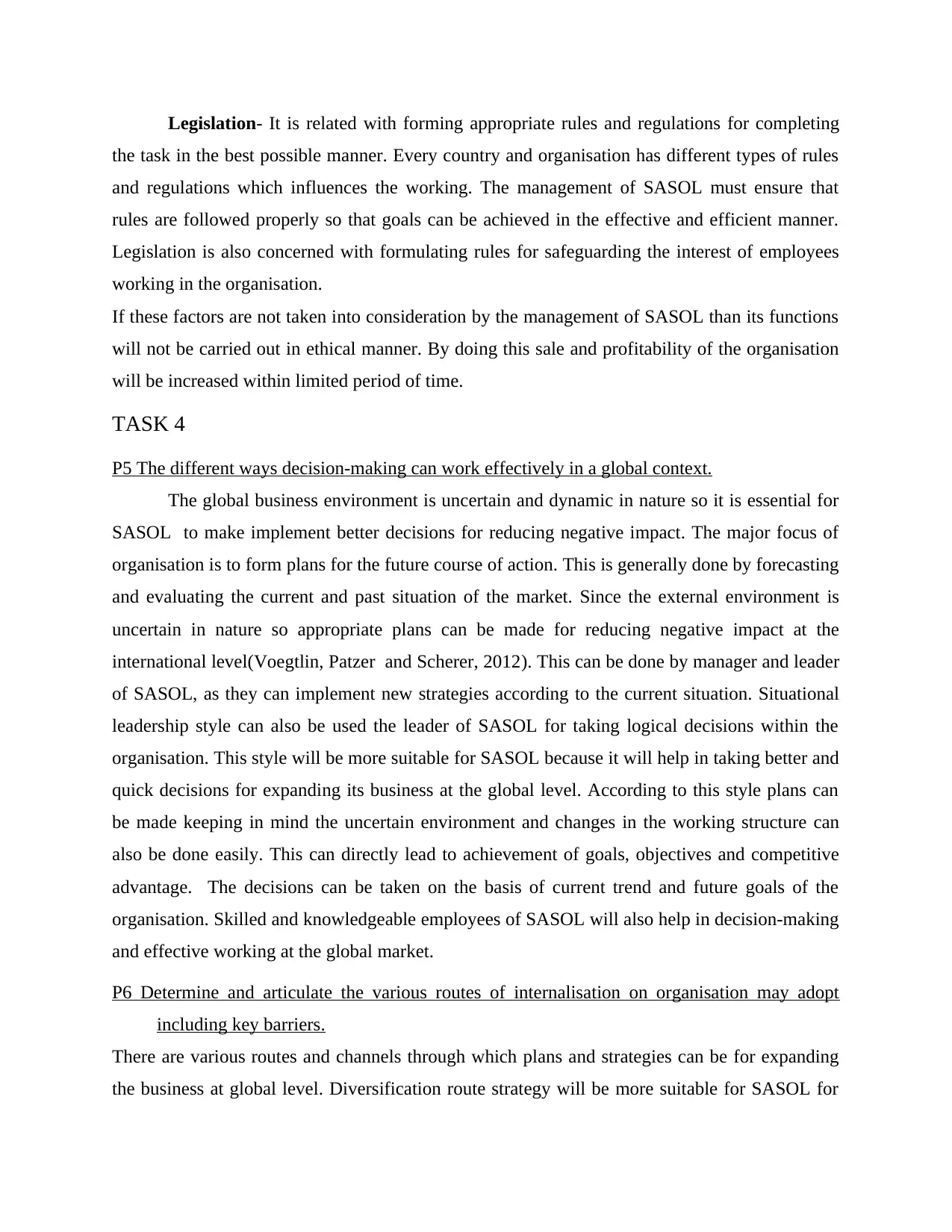
Legislation- It is related with forming appropriate rules and regulations for completing
the task in the best possible manner. Every country and organisation has different types of rules
and regulations which influences the working. The management of SASOL must ensure that
rules are followed properly so that goals can be achieved in the effective and efficient manner.
Legislation is also concerned with formulating rules for safeguarding the interest of employees
working in the organisation.
If these factors are not taken into consideration by the management of SASOL than its functions
will not be carried out in ethical manner. By doing this sale and profitability of the organisation
will be increased within limited period of time.
TASK 4
P5 The different ways decision-making can work effectively in a global context.
The global business environment is uncertain and dynamic in nature so it is essential for
SASOL to make implement better decisions for reducing negative impact. The major focus of
organisation is to form plans for the future course of action. This is generally done by forecasting
and evaluating the current and past situation of the market. Since the external environment is
uncertain in nature so appropriate plans can be made for reducing negative impact at the
international level(Voegtlin, Patzer and Scherer, 2012). This can be done by manager and leader
of SASOL, as they can implement new strategies according to the current situation. Situational
leadership style can also be used the leader of SASOL for taking logical decisions within the
organisation. This style will be more suitable for SASOL because it will help in taking better and
quick decisions for expanding its business at the global level. According to this style plans can
be made keeping in mind the uncertain environment and changes in the working structure can
also be done easily. This can directly lead to achievement of goals, objectives and competitive
advantage. The decisions can be taken on the basis of current trend and future goals of the
organisation. Skilled and knowledgeable employees of SASOL will also help in decision-making
and effective working at the global market.
P6 Determine and articulate the various routes of internalisation on organisation may adopt
including key barriers.
There are various routes and channels through which plans and strategies can be for expanding
the business at global level. Diversification route strategy will be more suitable for SASOL for
the task in the best possible manner. Every country and organisation has different types of rules
and regulations which influences the working. The management of SASOL must ensure that
rules are followed properly so that goals can be achieved in the effective and efficient manner.
Legislation is also concerned with formulating rules for safeguarding the interest of employees
working in the organisation.
If these factors are not taken into consideration by the management of SASOL than its functions
will not be carried out in ethical manner. By doing this sale and profitability of the organisation
will be increased within limited period of time.
TASK 4
P5 The different ways decision-making can work effectively in a global context.
The global business environment is uncertain and dynamic in nature so it is essential for
SASOL to make implement better decisions for reducing negative impact. The major focus of
organisation is to form plans for the future course of action. This is generally done by forecasting
and evaluating the current and past situation of the market. Since the external environment is
uncertain in nature so appropriate plans can be made for reducing negative impact at the
international level(Voegtlin, Patzer and Scherer, 2012). This can be done by manager and leader
of SASOL, as they can implement new strategies according to the current situation. Situational
leadership style can also be used the leader of SASOL for taking logical decisions within the
organisation. This style will be more suitable for SASOL because it will help in taking better and
quick decisions for expanding its business at the global level. According to this style plans can
be made keeping in mind the uncertain environment and changes in the working structure can
also be done easily. This can directly lead to achievement of goals, objectives and competitive
advantage. The decisions can be taken on the basis of current trend and future goals of the
organisation. Skilled and knowledgeable employees of SASOL will also help in decision-making
and effective working at the global market.
P6 Determine and articulate the various routes of internalisation on organisation may adopt
including key barriers.
There are various routes and channels through which plans and strategies can be for expanding
the business at global level. Diversification route strategy will be more suitable for SASOL for
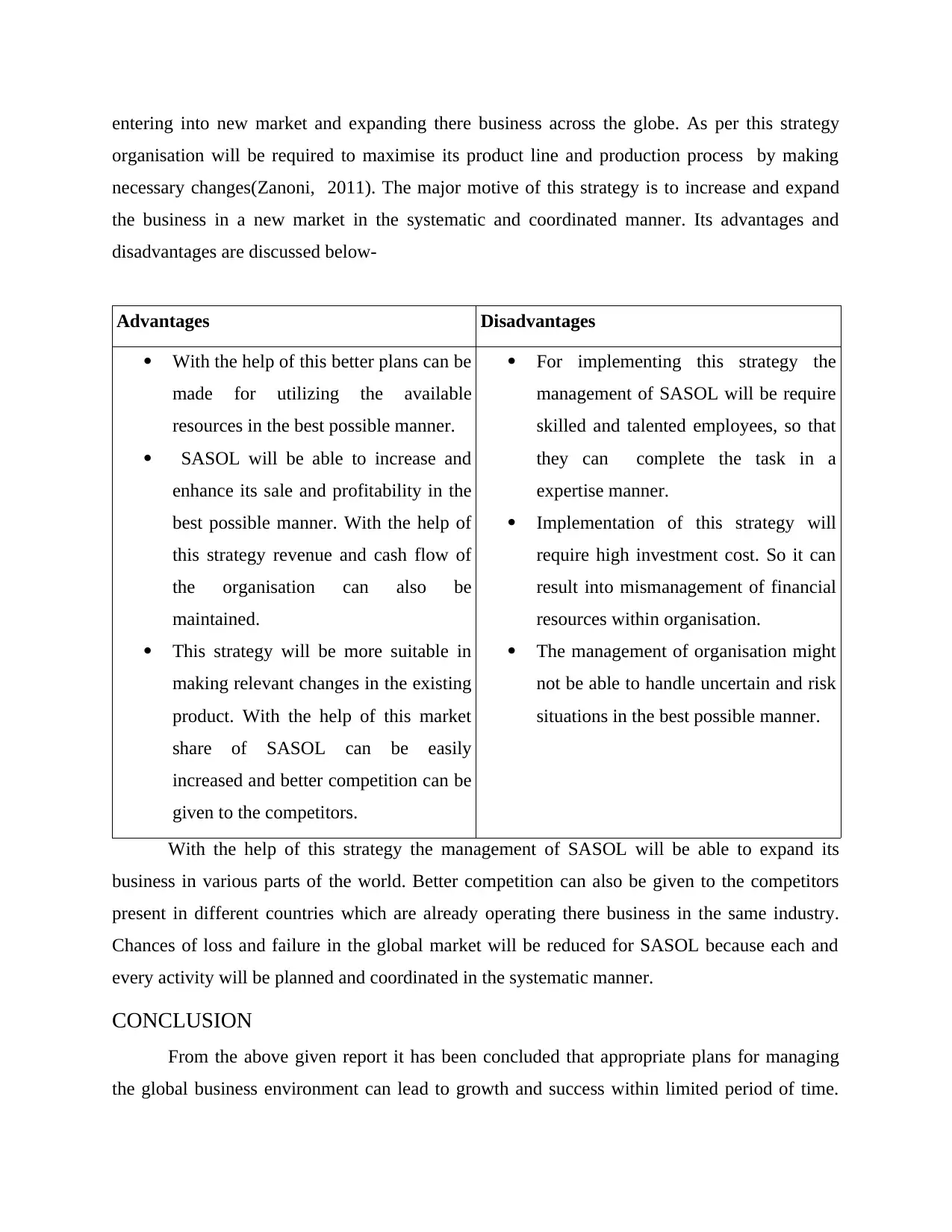
entering into new market and expanding there business across the globe. As per this strategy
organisation will be required to maximise its product line and production process by making
necessary changes(Zanoni, 2011). The major motive of this strategy is to increase and expand
the business in a new market in the systematic and coordinated manner. Its advantages and
disadvantages are discussed below-
Advantages Disadvantages
With the help of this better plans can be
made for utilizing the available
resources in the best possible manner.
SASOL will be able to increase and
enhance its sale and profitability in the
best possible manner. With the help of
this strategy revenue and cash flow of
the organisation can also be
maintained.
This strategy will be more suitable in
making relevant changes in the existing
product. With the help of this market
share of SASOL can be easily
increased and better competition can be
given to the competitors.
For implementing this strategy the
management of SASOL will be require
skilled and talented employees, so that
they can complete the task in a
expertise manner.
Implementation of this strategy will
require high investment cost. So it can
result into mismanagement of financial
resources within organisation.
The management of organisation might
not be able to handle uncertain and risk
situations in the best possible manner.
With the help of this strategy the management of SASOL will be able to expand its
business in various parts of the world. Better competition can also be given to the competitors
present in different countries which are already operating there business in the same industry.
Chances of loss and failure in the global market will be reduced for SASOL because each and
every activity will be planned and coordinated in the systematic manner.
CONCLUSION
From the above given report it has been concluded that appropriate plans for managing
the global business environment can lead to growth and success within limited period of time.
organisation will be required to maximise its product line and production process by making
necessary changes(Zanoni, 2011). The major motive of this strategy is to increase and expand
the business in a new market in the systematic and coordinated manner. Its advantages and
disadvantages are discussed below-
Advantages Disadvantages
With the help of this better plans can be
made for utilizing the available
resources in the best possible manner.
SASOL will be able to increase and
enhance its sale and profitability in the
best possible manner. With the help of
this strategy revenue and cash flow of
the organisation can also be
maintained.
This strategy will be more suitable in
making relevant changes in the existing
product. With the help of this market
share of SASOL can be easily
increased and better competition can be
given to the competitors.
For implementing this strategy the
management of SASOL will be require
skilled and talented employees, so that
they can complete the task in a
expertise manner.
Implementation of this strategy will
require high investment cost. So it can
result into mismanagement of financial
resources within organisation.
The management of organisation might
not be able to handle uncertain and risk
situations in the best possible manner.
With the help of this strategy the management of SASOL will be able to expand its
business in various parts of the world. Better competition can also be given to the competitors
present in different countries which are already operating there business in the same industry.
Chances of loss and failure in the global market will be reduced for SASOL because each and
every activity will be planned and coordinated in the systematic manner.
CONCLUSION
From the above given report it has been concluded that appropriate plans for managing
the global business environment can lead to growth and success within limited period of time.
Secure Best Marks with AI Grader
Need help grading? Try our AI Grader for instant feedback on your assignments.
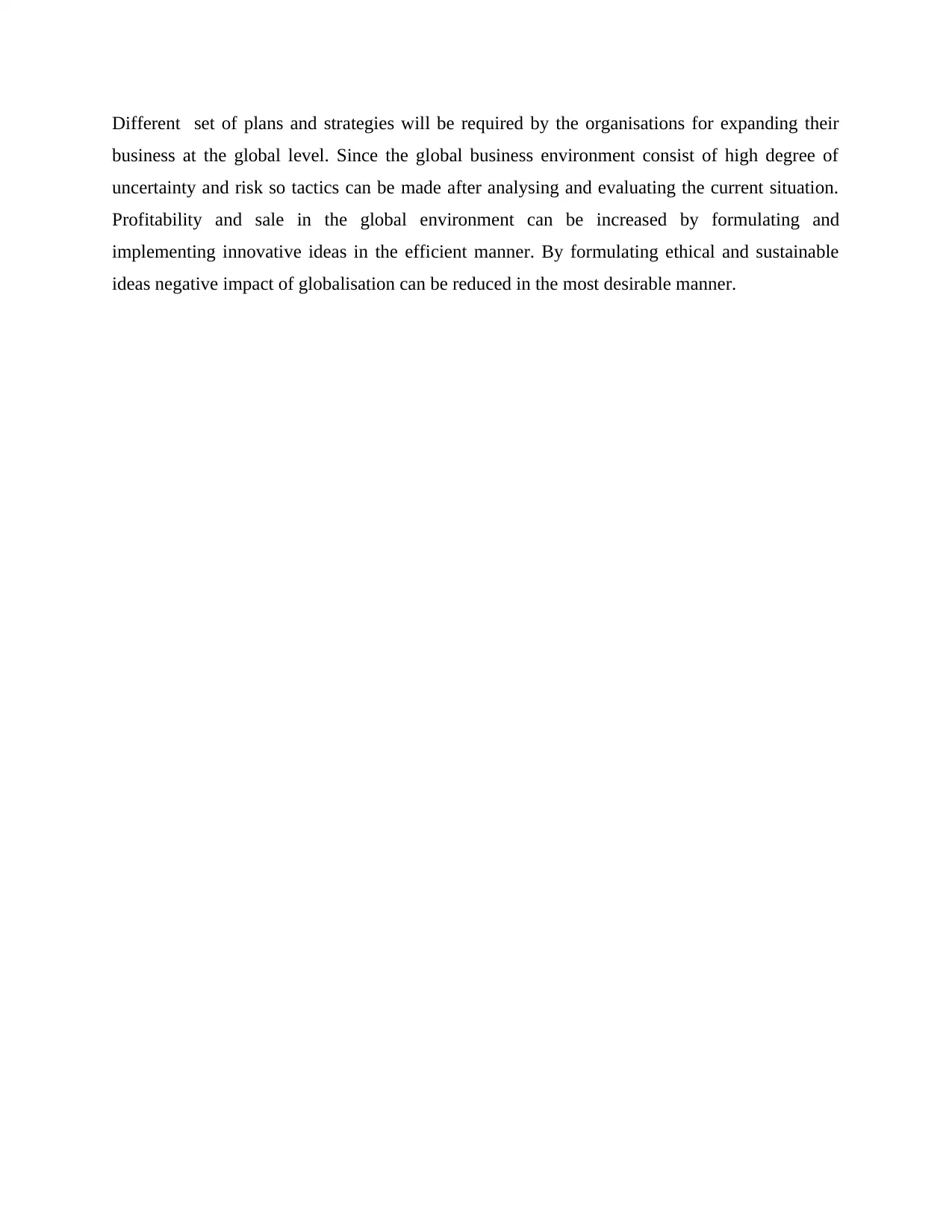
Different set of plans and strategies will be required by the organisations for expanding their
business at the global level. Since the global business environment consist of high degree of
uncertainty and risk so tactics can be made after analysing and evaluating the current situation.
Profitability and sale in the global environment can be increased by formulating and
implementing innovative ideas in the efficient manner. By formulating ethical and sustainable
ideas negative impact of globalisation can be reduced in the most desirable manner.
business at the global level. Since the global business environment consist of high degree of
uncertainty and risk so tactics can be made after analysing and evaluating the current situation.
Profitability and sale in the global environment can be increased by formulating and
implementing innovative ideas in the efficient manner. By formulating ethical and sustainable
ideas negative impact of globalisation can be reduced in the most desirable manner.
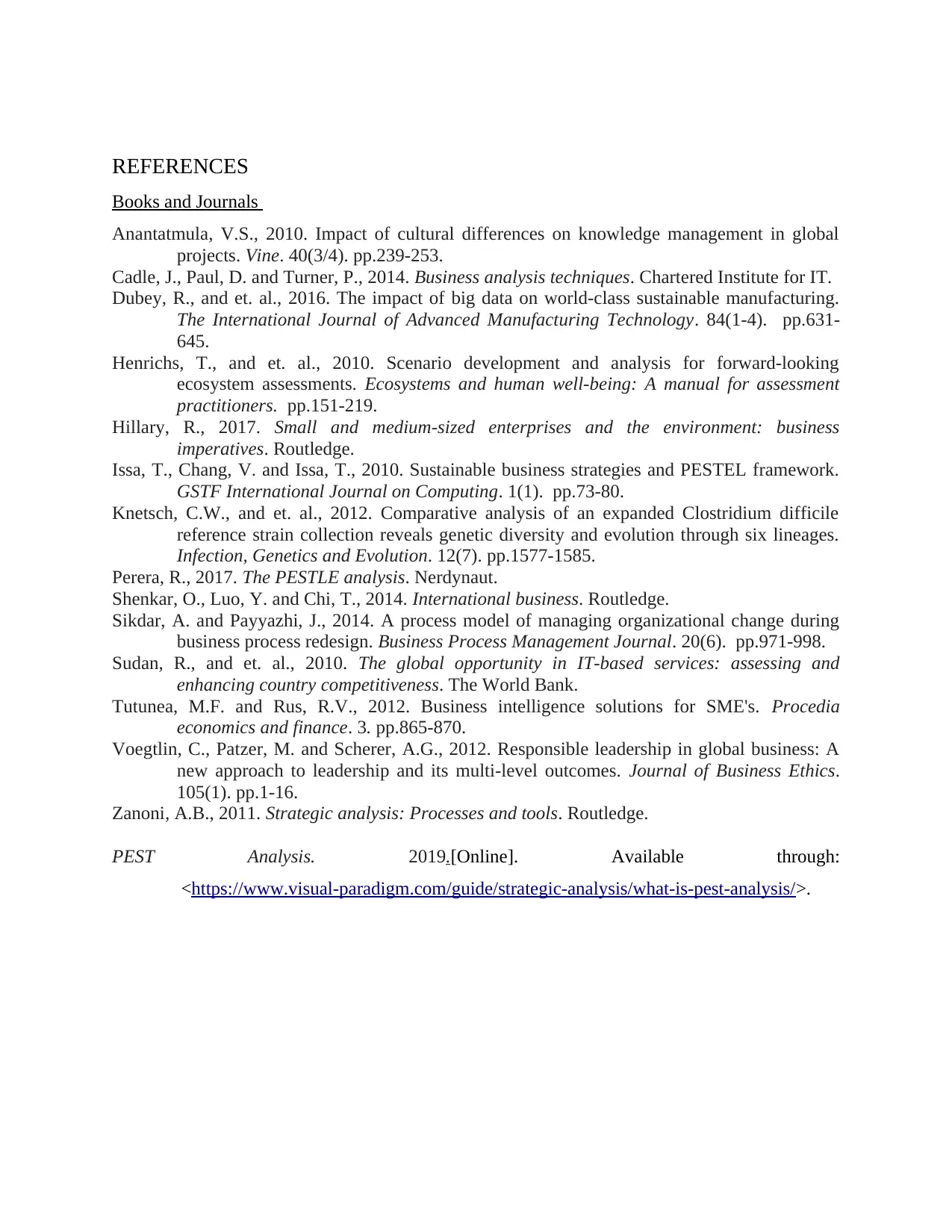
REFERENCES
Books and Journals
Anantatmula, V.S., 2010. Impact of cultural differences on knowledge management in global
projects. Vine. 40(3/4). pp.239-253.
Cadle, J., Paul, D. and Turner, P., 2014. Business analysis techniques. Chartered Institute for IT.
Dubey, R., and et. al., 2016. The impact of big data on world-class sustainable manufacturing.
The International Journal of Advanced Manufacturing Technology. 84(1-4). pp.631-
645.
Henrichs, T., and et. al., 2010. Scenario development and analysis for forward-looking
ecosystem assessments. Ecosystems and human well-being: A manual for assessment
practitioners. pp.151-219.
Hillary, R., 2017. Small and medium-sized enterprises and the environment: business
imperatives. Routledge.
Issa, T., Chang, V. and Issa, T., 2010. Sustainable business strategies and PESTEL framework.
GSTF International Journal on Computing. 1(1). pp.73-80.
Knetsch, C.W., and et. al., 2012. Comparative analysis of an expanded Clostridium difficile
reference strain collection reveals genetic diversity and evolution through six lineages.
Infection, Genetics and Evolution. 12(7). pp.1577-1585.
Perera, R., 2017. The PESTLE analysis. Nerdynaut.
Shenkar, O., Luo, Y. and Chi, T., 2014. International business. Routledge.
Sikdar, A. and Payyazhi, J., 2014. A process model of managing organizational change during
business process redesign. Business Process Management Journal. 20(6). pp.971-998.
Sudan, R., and et. al., 2010. The global opportunity in IT-based services: assessing and
enhancing country competitiveness. The World Bank.
Tutunea, M.F. and Rus, R.V., 2012. Business intelligence solutions for SME's. Procedia
economics and finance. 3. pp.865-870.
Voegtlin, C., Patzer, M. and Scherer, A.G., 2012. Responsible leadership in global business: A
new approach to leadership and its multi-level outcomes. Journal of Business Ethics.
105(1). pp.1-16.
Zanoni, A.B., 2011. Strategic analysis: Processes and tools. Routledge.
PEST Analysis. 2019.[Online]. Available through:
<https://www.visual-paradigm.com/guide/strategic-analysis/what-is-pest-analysis/>.
Books and Journals
Anantatmula, V.S., 2010. Impact of cultural differences on knowledge management in global
projects. Vine. 40(3/4). pp.239-253.
Cadle, J., Paul, D. and Turner, P., 2014. Business analysis techniques. Chartered Institute for IT.
Dubey, R., and et. al., 2016. The impact of big data on world-class sustainable manufacturing.
The International Journal of Advanced Manufacturing Technology. 84(1-4). pp.631-
645.
Henrichs, T., and et. al., 2010. Scenario development and analysis for forward-looking
ecosystem assessments. Ecosystems and human well-being: A manual for assessment
practitioners. pp.151-219.
Hillary, R., 2017. Small and medium-sized enterprises and the environment: business
imperatives. Routledge.
Issa, T., Chang, V. and Issa, T., 2010. Sustainable business strategies and PESTEL framework.
GSTF International Journal on Computing. 1(1). pp.73-80.
Knetsch, C.W., and et. al., 2012. Comparative analysis of an expanded Clostridium difficile
reference strain collection reveals genetic diversity and evolution through six lineages.
Infection, Genetics and Evolution. 12(7). pp.1577-1585.
Perera, R., 2017. The PESTLE analysis. Nerdynaut.
Shenkar, O., Luo, Y. and Chi, T., 2014. International business. Routledge.
Sikdar, A. and Payyazhi, J., 2014. A process model of managing organizational change during
business process redesign. Business Process Management Journal. 20(6). pp.971-998.
Sudan, R., and et. al., 2010. The global opportunity in IT-based services: assessing and
enhancing country competitiveness. The World Bank.
Tutunea, M.F. and Rus, R.V., 2012. Business intelligence solutions for SME's. Procedia
economics and finance. 3. pp.865-870.
Voegtlin, C., Patzer, M. and Scherer, A.G., 2012. Responsible leadership in global business: A
new approach to leadership and its multi-level outcomes. Journal of Business Ethics.
105(1). pp.1-16.
Zanoni, A.B., 2011. Strategic analysis: Processes and tools. Routledge.
PEST Analysis. 2019.[Online]. Available through:
<https://www.visual-paradigm.com/guide/strategic-analysis/what-is-pest-analysis/>.
1 out of 12
Related Documents
Your All-in-One AI-Powered Toolkit for Academic Success.
+13062052269
info@desklib.com
Available 24*7 on WhatsApp / Email
![[object Object]](/_next/static/media/star-bottom.7253800d.svg)
Unlock your academic potential
© 2024 | Zucol Services PVT LTD | All rights reserved.



